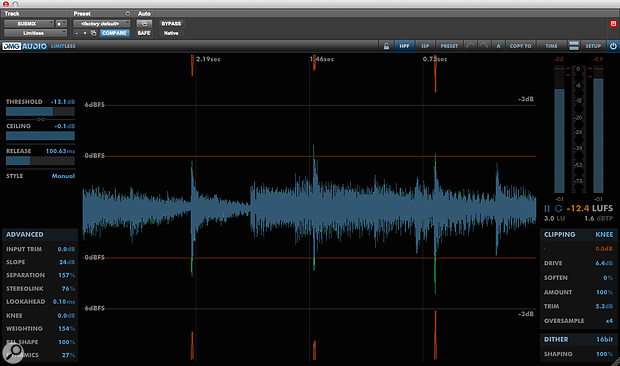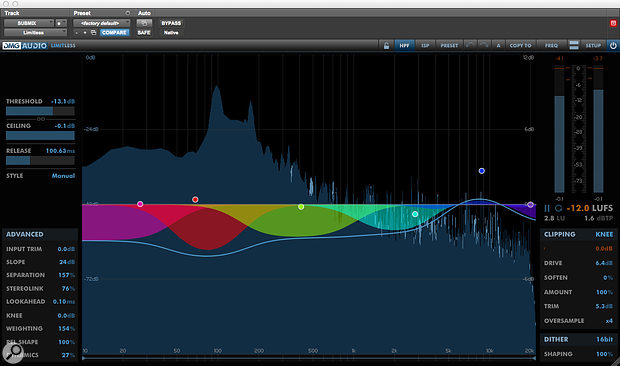If you’re feeling limited by your existing limiter, perhaps DMG Audio have the answer?
Dave Gamble is a plug-in developer who sets out to make his products the very last word in whatever it is they do. His Equilibrium equaliser and Compassion compressor are already the most comprehensive examples of those two processors I’ve ever come across, and now he’s turned his attention to the challenge of creating the ultimate plug-in mastering limiter.
At first glance, this seems like a less ambitious goal than designing the mother of all equalisers, or the compressor to end all compressors. After all, a mastering limiter is intended to do one very specific thing: to make your mixes as loud as possible, with as few side-effects as possible. Many limiting plug-ins thus have hardly any user controls beyond a simple threshold or gain setting — but you probably won’t be surprised to learn that DMG Audio’s Limitless is not among them.
Three Steps To Heaven
Putting a simple output limiter across the master bus is fine when you need to send clients a quick reference mix, but mastering engineers in pursuit of the best results will often use more than one stage of processing. The reason for this is that dynamic variation within programme audio happens on different timescales. At the ‘micro’ level, most mixes contain instantaneous, transient peaks caused by events such as drum hits; but the level of the audio also changes in a ‘macro’ fashion too. To achieve the loudest possible master with the fewest possible side-effects, it may be necessary to tackle longer-term dynamic variation separately from the transient peaks. What’s more, many mastering engineers don’t only use limiting to control the latter: there are cases where allowing transients to clip the input of an A-D converter can actually sound more natural than having a limiter do all the work.
Limitless reflects this approach and includes not one but three processing stages, all of them highly configurable. Two separate limiters are designed to work in tandem; the first is intended to allow transient events to pass through, but control dynamic variation with slower attack and release characteristics. The second then squishes the transients, in conjunction with the third of Limitless’s processing elements: a soft-clip stage preceding the limiter, which can mimic the characteristics of several different clipping options.
The limiting can be configured as a conventional full-bandwidth process, but Limitless also offers the option to have it operate independently in up to six frequency bands. This can help to achieve natural-sounding results with material that has loud peaks in specific frequency ranges, because you can ensure that other areas of the spectrum are not ducked along with the peaking frequencies.
Soft & GUI
There are times when the sheer range of options available in Compassion or Equilibrium can feel overwhelming, but that’s not the case here. Although Limitless is easily the most comprehensively featured limiter I’ve ever come across, DMG have managed to harness all of its power within a friendly and well thought-out user interface.
By default, Limitless opens in a fairly small window that presents only the main Threshold, Ceiling and Release time controls on the left, and the output meters on the right. However, the window can be freely resized, and clicking a small icon in the plug-in toolbar makes visible a list of additional parameters in the lower left and right panes. The large central section, meanwhile, is devoted to visualising the settings of the band crossovers and the effect of any limiting on the input signal.
 Limitless’s ‘time view’ shows the input signal as a scrolling waveform display. The green sections show where the limiter is active, and the red lines indicate gain reduction taking place.
Limitless’s ‘time view’ shows the input signal as a scrolling waveform display. The green sections show where the limiter is active, and the red lines indicate gain reduction taking place.
The default visualisation shows an FFT-style instantaneous plot of peak level across the frequency spectrum; when the limiter bands are applying gain reduction, the top part of the graph turns a lighter shade of blue. On this is superimposed a fairly conventional EQ-like interface which allows you to configure the band splitting. A simple click enables and disables the bands, while clicking and dragging adjusts the gain and centre frequency of each (though this behaviour can be customised). If you so choose, this frequency view can be replaced by a neat scrolling waveform display that can be sync’ed to song tempo, with limiter activity displayed in red and green above and below the programme audio.
These two basic alternatives complement each other nicely: the frequency view gives you a clear idea of how the energy within your mix is distributed across the spectrum, and how the limiter is behaving in each band, while the time view lets you pinpoint how much limiting is taking place at any given moment. And if your main concern is to hit a particular peak loudness value, another alternative visualisation supplements the numerical LUFS readout below the main output meters with a scrolling histogram. The behaviour of all of these displays is highly configurable, thanks to a range of global and instance-only preferences, accessed from the Setup button.
Don’t Cramp My Style
Limitless is not the first limiter I’ve used that offers different ‘styles’ of limiting, with names such as ‘punchy’, ‘transparent’, ‘aggressive’ and ‘smooth’. What is new, at least to me, is the extent to which the intrepid user can dive in and adjust the various parameters that make up a style. When you select one of Limitless’s preset styles, only four additional ‘expert’ parameters are visible in the expanded interface, but if you choose the ‘manual’ style, or copy one of the preset styles so that it can be edited as a manual style, you get the full list of Advanced controls. These include such factors as lookahead, knee, ‘weighting’ — which sets how gain reduction is distributed between different frequency bands — release ‘shape’ and finally Dynamics, which controls how much of the work should be done by the transient limiter and how much by the peak limiter.
 With the additional ‘expert’ controls hidden, Limitless presents only the three basic sliders. Here, the main window is showing the integrated loudness display.
With the additional ‘expert’ controls hidden, Limitless presents only the three basic sliders. Here, the main window is showing the integrated loudness display.
Engage Clipping on the right-hand side of the interface, and here, too, you’ll be presented with plenty of control over the process. Three different flavours of clipping are on offer; the two ’swell’ options are described as “simple waveshapers which mostly add third-harmonic distortion to increase perceived level”, while ‘knee’ offers hard converter-style clipping at one end of the spectrum and smoother soft clipping at the other. Reducing the Amount control from 100 percent lets you mix in some of the dry, unclipped signal, and there are also Drive and Trim controls.
No No, No No There’s No Limits
In practice, I found Limitless’s multi-level interface very well thought-out. Thanks to the simple default view, you can be up and limiting within seconds of installing it, and the results are good enough that I can imagine many users never needing to take things further. But when you do delve deeper, you quickly begin to get a feel for which styles of limiting suit different types of programme material; and when you go further still, you soon start to understand which controls are key in creating your own custom settings. Though you don’t have to use it, the multiband option can be really effective when you need more level with fewer side-effects. I’ve used similar features before in plug-ins like Waves’ L3, but what was really a revelation to me in Limitless was the clipping. I’m sure most of us have found that saturation or ‘analogue warmth’ plug-ins on the master bus can give a welcome increase in apparent loudness without bringing up the peak level, and you can achieve something of the sort here using the softer clipping options, but what surprised me was how hard you can push the clipping in ‘knee’ mode without audible side-effects.
When a plug-in sounds great and is absurdly comprehensive, yet easy to use, you have to dig pretty hard to find anything to complain about, and I haven’t even mentioned the many little touches that help to elevate Limitless above the herd. There is, for instance, an excellent PDF manual, while features like the built-in high-pass filter, optional inter-sample peak detection, constant-gain monitoring and very flexible dither noise shaping are all welcome if you need them and easy to ignore if you don’t. All in all, I can’t recommend Limitless highly enough. Not only is it immensely flexible and capable of a lot of very transparent gain reduction, it’s also more affordable than many alternatives, and surprisingly economical on CPU load. Limitless has already become my first-choice output limiter, and it’ll be interesting to see if anything else out there can top it.
Alternatives
There are already many excellent limiting plug-ins on the market, though I don’t know of any that are quite as configurable as Limitless. Alternatives worth investigating include Waves’ L3-16, FabFilter’s Pro-L, Sonnox’s Oxford Limiter, Slate Digital’s FG-X and IK Multimedia’s Stealth Limiter.
Pros
- Extremely configurable, yet easy to use and immediate.
- Its three-stage multiband processing can achieve impressive levels of transparent gain reduction.
- Excellent graphical feedback.
- Sensibly priced and not too CPU-intensive.
Cons
- None.
Summary
Whether you want a good-sounding ‘set and forget’ limiter or a processor that allows you to dive in and fine-tune every last parameter, Limitless ticks all the boxes.

